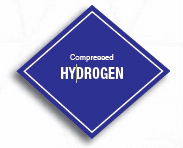
- Image via Wikipedia
Ask people to think of the ultimate future car, and their answer is often K.I.T.T. — the legendary talking supercar from the US television series “Knight Rider.”
A hydrogen turbo motor fuels the fantasy vehicle and propels it on the chase for the bad guys at over 300 miles an hour. In the future, cars may be equipped with hydrogen propulsion not just in TV shows, but in real life as well.
In the transportation and energy sectors, hydrogen is viewed as an eventual alternative to the raw materials of fossil-fuel power, such as coal, petroleum and natural gas. However, for metals like steel, aluminum and magnesium — which are commonly used in automotive and energy technology — hydrogen is not quite ideal. It can make these metals brittle; the ductility of the metal becomes reduced. Its durability deteriorates. This can lead to sudden failure of parts and components. Beside the fuel tank itself, or parts of the fuel cell, but ordinary components like ball bearings could also be affected. These are found not only in the car, but also in almost all industrial machinery.
This lightest of the chemical elements permeates the raw materials of which the vehicle is made not only when filling the tank, but also through various manufacturing processes. Hydrogen can infiltrate the metal lattice through corrosion, or during chromium-plating of car parts. Infiltration may likewise occur during welding, milling or pressing. The result is always the same: the material may tear or break without warning. Costly repairs are the consequence. To prevent cracks and breakage in the future, the researchers at the Fraunhofer Institute for Mechanics of Materials IWM in Freiburg are studying hydrogen-induced embrittlement. Their objective: to find materials and manufacturing processes that are compatible with hydrogen.
“With our new special laboratory, we are investigating how and at which speed hydrogen migrates through a metal. We are able to detect the points at which the element accumulates in the material, and where it doesn’t,” says Nicholas Winzer, researcher at IWM.
Since the risk potential mostly emanates from the diffusible, and therefore mobile, portion of the hydrogen, it is necessary to separate this from the entire hydrogen content. Researchers can release and simultaneously measure the movable part of the hydrogen by heat treatment, where samples are continuously heated up. In addition, the experts can measure the rate that hydrogen is transported through the metal while simultaneously applying stress to the material samples mechanically. They can determine how the hydrogen in the metal behaves when tension is increased. For this purpose, the scientists use special tensile test equipment that permit simultaneous mechanical loading and infiltration with hydrogen. Next, they determine how resistant the material is. “In industry, components have to withstand the combined forces of temperature, mechanical stress and hydrogen. With the new special laboratory, we can provide the necessary analytical procedures,” as Winzer explains the special feature of the simultaneous tests.









